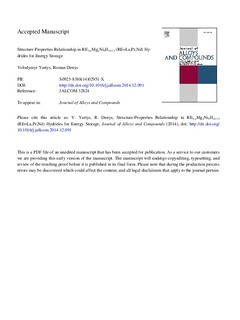| dc.contributor.author | Yartys, Volodymyr | |
| dc.contributor.author | Denys, Roman Volodymyrovich | |
| dc.date.accessioned | 2017-09-26T14:45:12Z | |
| dc.date.available | 2017-09-26T14:45:12Z | |
| dc.date.created | 2015-09-17T08:22:17Z | |
| dc.date.issued | 2014 | |
| dc.identifier.citation | Journal of Alloys and Compounds. 2015, 645 (1), S412-S418. | nb_NO |
| dc.identifier.issn | 0925-8388 | |
| dc.identifier.uri | http://hdl.handle.net/11250/2456906 | |
| dc.description.abstract | Ternary RE3xMgxNi9 intermetallics are promising battery electrode materials. Studies of the structure– properties relationships in the (La,Pr,Nd)3xMgxNi9H10–13 hydrides and initial intermetallics revealed the following: (a) Increase of magnesium content causes a gradual shrinking of the trigonal unit cells (a, c, V) for all studied RE metals, with the highest solubility range of Mg reached in REMg2Ni9; (b) Significant lowering of the thermodynamic stability follows an increase in magnesium content from x = 1.0 to 1.1–1.2 and a replacement of La by Pr and Nd, with desorption pressures changing in a broad range, from 0.01 bar to 20 bar H2; (c) Neutron powder diffraction shows a nearly equal distribution of D atoms within the REMgNi4 and RENi5 layers; (d) Local hydrogen ordering occurs within the H-sublattice built from MgH6 octahedra and NiH4 tetrahedra displaying a directional metal–hydrogen bonding. A partial substitution of Mg for RE allows the electrochemical discharge capacity of the (La,Pr,Nd)3xMgxNi9 hydrides to become 25% greater than that of the commercial AB5-type electrodes, reaching 400 mA h/g. Synthesis of the materials with a high degree of homogeneity is important and has been achieved by choosing an appropriate synthesis route, content of Mg in the initial mixtures, and time and temperature of the homogenisation process. | nb_NO |
| dc.language.iso | eng | nb_NO |
| dc.publisher | Elsevier | nb_NO |
| dc.rights | Attribution-NonCommercial-NoDerivatives 4.0 Internasjonal | * |
| dc.rights.uri | http://creativecommons.org/licenses/by-nc-nd/4.0/deed.no | * |
| dc.title | Structure–properties relationship in RE3−xMgxNi9H10–13 (RE = La,Pr,Nd) hydrides for energy storage | nb_NO |
| dc.type | Journal article | nb_NO |
| dc.type | Peer reviewed | nb_NO |
| dc.description.version | acceptedVersion | nb_NO |
| dc.source.pagenumber | S412-S418 | nb_NO |
| dc.source.volume | 645 | nb_NO |
| dc.source.journal | Journal of Alloys and Compounds | nb_NO |
| dc.source.issue | 1 | nb_NO |
| dc.identifier.doi | 10.1016/j.jallcom.2014.12.091 | |
| dc.identifier.cristin | 1264872 | |
| dc.relation.project | Norges forskningsråd: 203323 | nb_NO |
| dc.description.localcode | This is the authors’ accepted and refereed manuscript to the article. Author's post-print is released with a Creative Commons Attribution Non-Commercial No Derivatives License, CC-BY-NC-ND. | nb_NO |
| cristin.unitcode | 194,66,35,0 | |
| cristin.unitname | Institutt for materialteknologi | |
| cristin.ispublished | true | |
| cristin.fulltext | postprint | |
| cristin.qualitycode | 1 | |

